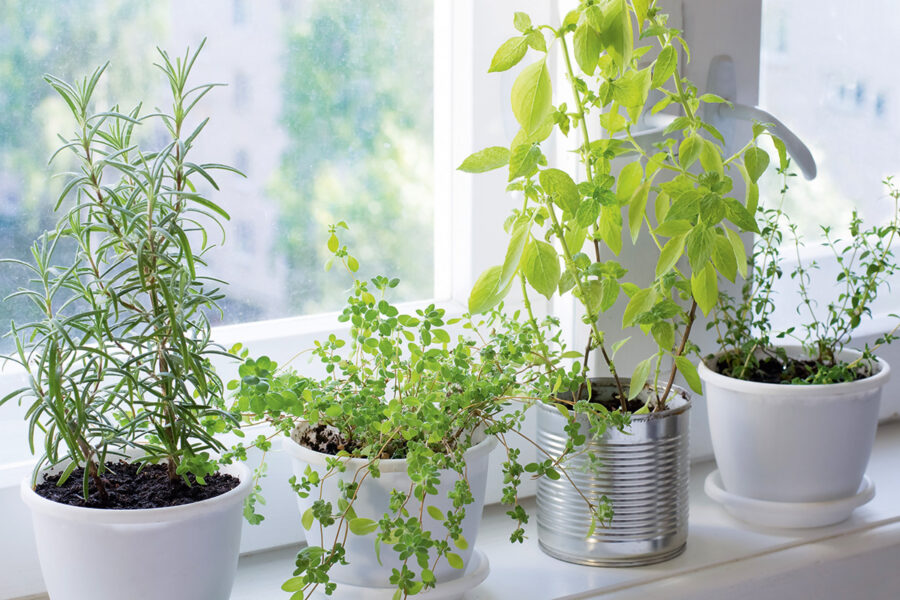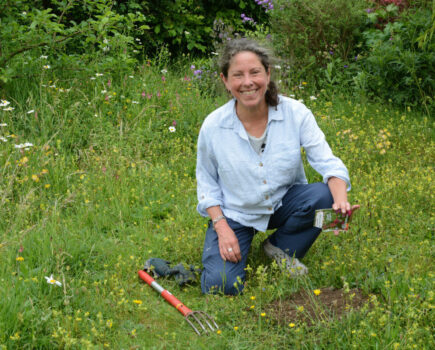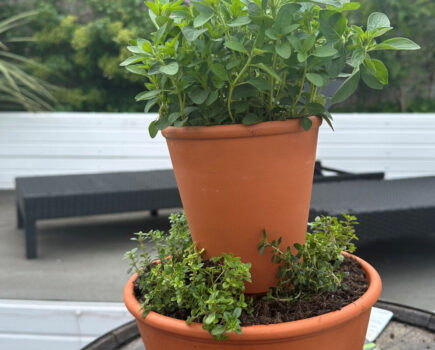Kim Soddart shows you how to grow easy indoor edibles this month…
In the darkest depths of December as the daylight hours continue to tumble away, there is a lot to be said for finding excuses, any excuse to still garden. Yes it is mainly cold, wet and miserable outside and the ground is still sodden from the multifarious storms of these past few weeks, yet this is all the more reason to look instead a lot closer to home.
There are still opportunities for indoor edible cultivation and it’s incredibly rewarding to do so. The simple pleasure of germinating some coriander seed for luscious, zesty pick-and-come-again leaves can bring some sunshine to your day no matter the weather. To have the excuse to watch as seeds dutifully burst into new life, is mesmerising and magical in equal measure. It can also bring lots of extra fresh edibles to the table, save money and bring some homegrown joy inside.
Where to grow
On or near a sunny windowsill would be ideal as light is always an important consideration once seed has been germinated and plants are growing away. A warmer spot will help boost growth, although all of the edibles I’m about to outline can stand firm over winter under cover.
1. Pea shoots

These delectable leaves are easy to grow and make a most welcome addition to any winter salad. They are also good as decoration on food and they taste delicious.
As well as any leftover pea seed you happen to have in your collection, dried store peas (those packets that are often found lurking in the back of the cupboard) can also be used and grown on for shoots.
After choosing your tray of choice (even an old supermarket mushroom tray can work well), then fill it with multipurpose compost and sow seed thickly (about an inch) apart to enable lots of lovely pick and come again opportunities.
These seedlings won’t be suitable to plant out next year, as they will be exhausted after multiple pickings, but they do provide lovely winter harvests and as they grow they can be potted on into fresh compost for more pea shoots.
2. Pick of the parsley

I would say if you grow anything indoors over winter make it something herby. The sheer pleasure of the aroma and culinary opportunities they afford, make them a priority in my book.
Herbs are also incredibly good for you in a myriad of exciting ways, so having them so close to the kitchen means they are easily accessible for picking. I add the likes of parsley in particular to most dishes at this time of year because of its fantastic flavour but also because it is packed full of vitamin C to help see me through the winter months.
Your choices with parsley are to either bring some plants from outside in to grow under cover where they are then
able to put on some slow growth, or to to divide supermarket herb pots (battery herbs I call them) and plant them on. Whichever option you choose, cut the plants back and harvest some leaves after placing them in their new comfy home with more spacious quarters, as this will help them conserve energy for growth.
3. Mint and coriander

I bunch these two together, but not because they like each other (they don’t!) but because I want to fit in some more edible growing ideas in my scheduled five!
Mint is a resilient rascal so if you know where you have some growing outside you could remove a section of white underground stem (and root if possible) to plant on in compost indoors. You just know it will take full advantage. You can also take a cutting from a supermarket sprig. Remove the lower leaves and place in a shallow glass of water in a warm, sunny spot and it’s fun to watch as the roots begin to emerge. The seedlings are ready for planting on when you have a good inch of root formation.
It’s worth changing the water about once a week. It always amazes me how quickly they root. In the summer it can be just a matter of days before the cuttings start bursting into new life.
Coriander requires seed germination for healthy pickings at this time of year, and so it is best to dip into your packets of seed. Sow seed thickly, water lightly and cover with a cloche of some form to help them on their way. Smaller plants lend themselves well to pick-and-come-again opportunities and are better able to cope with the cold than their taller, leggier counterparts.
TIP: It’s worth also trying to work with any coriander spice seed you might also have to save having to buy any new packets.
4. More leaf picking options

I favour the loose leaf lettuce for winter pickings such as ‘salad bowl’ because you are less likely to find something slimy lurking inside and it lends itself better to multiple pickings.
I also like flat leaf kale, rocket and chard for the same reasons and grow some plants inside as well as out. I have polytunnels and cold frames outdoors, but I enjoy having leaves closer to hand. You can get creative with what you grow them in making rather attractive indoor edible displays at this time of year.
I also grow some beetroot in the polytunnels for their lovely spinach-like leaves and you can do the same indoors. If you germinate seeds now for windowsill leaf pickings, the seedlings can be planted out come spring.
You might think they will have exhausted themselves over winter but you’ll be surprised how much a fresh batch of compost-laden loam can put a spring in their step. I do try to grow on everything I can and these experiments over the years never cease to amaze how plants can bounce back, given the chance.
5. Marvellous oyster mushrooms

There are so many different types of growing kits now available to purchase it can be confusing to know where to start. Oyster mushrooms are arguably the easiest mushroom to work with indoors. They aren’t that fussy about what they grow in and will happily fruit away on wood chip, compost, cardboard, books, denim, coffee grounds and probably other materials besides.
A starter kit which includes the mycelium (white spongey material from which your mushrooms fruit), growing medium and instructions is probably your best place to start if you want to enter the rather marvellous world of mushroom growing. You will get some hand holding through your first few flushes of mushroom as you get to know a little better how they work.
Then (and this is the exciting bit), you can take your mycelium (which will now have exhausted its food supply), divide it and plant it on. It is a living thing and only needs more food and space in which to spread and fruit. Your world of mushroom growing adventures truly starts here!
Find more tips, advice and articles like this at the Amateur Gardening website. Subscribe to Amateur Gardening magazine now.





